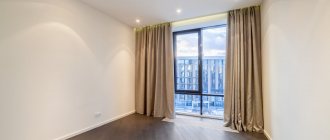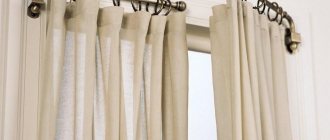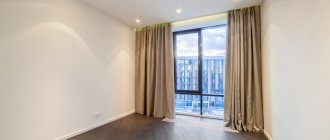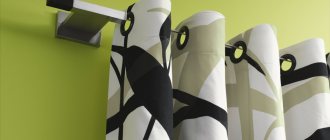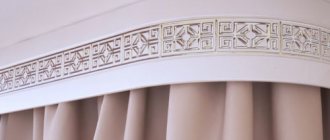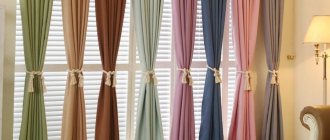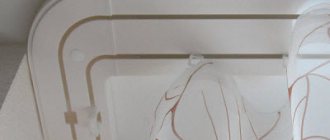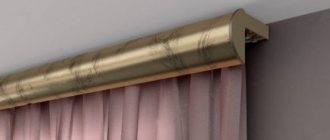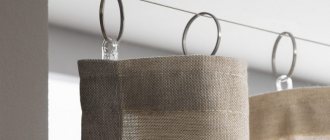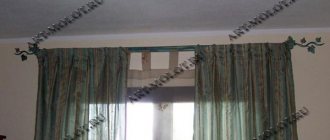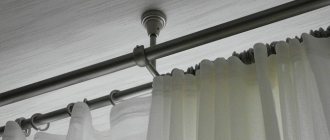Using hidden cornices in interior design
The popularity of these products when developing room design is explained by several reasons:
- Functional need to be used to create a harmonious environment. Often the need to install a hidden cornice is explained by the presence of a suspended ceiling structure in the room. This is due to the fact that it is prohibited to install any protruding rigid elements on the surface of such a ceiling, since they can damage the PVC film. Naturally, in this case you cannot use ordinary ceiling cornices. In addition, the wall fixation method must be safe for the film panel of the tension system. From this we can conclude that the cornice parts cannot come into contact with the material of the ceiling surface of the tension structure. The best solution in this case would be to install a hidden cornice.
- Commitment to adhere to the fundamental principles of modern design solutions. Nowadays, decorating window openings with curtains that seem to flow from the ceiling surface is considered a relevant and elegant technique for interior design. As a complement to such a non-standard design solution, they are decorated with lighting. To implement this idea, plasterboard structures are installed. If you choose to build a hidden cornice, it can be made straight, curved or semicircular. To do this, a special niche is made of plasterboard in the ceiling structure. Use it to hide the cornice.
There is another method for creating hidden cornices. This is the use of baguette structures, which are a type of standard wall mounts for curtains. Their peculiarity lies in the camouflage of all the elements of the hidden cornice under beautiful overlays, for the manufacture of which wood, metal or plastic is used.
Plastic or aluminum
Ceiling curtain rods made of plastic and aluminum are available for sale. If we compare these two materials, it is clear that metal is more reliable and stronger and can withstand greater loads. But if you use light curtains and curtains, it is quite possible to use plastic. You just need to look for ones with thick walls and it’s better to see and hold them in your hands so that you can evaluate the thickness of the walls and the quality of the casting.
Aluminum ceiling cornices are much more expensive, and with lightweight curtains the safety margin is simply not needed. Although, they, of course, can be used for many years. The same cannot be said about plastic, but the costs are several times lower. In general, it's up to you.
For heavy blackout curtains, ceiling curtain rods made of aluminum with a reinforced structure are needed
If the curtains are made of heavy material, then you will need aluminum ceiling curtain rods. Moreover, in the description, look for an indication that they are intended specifically for heavy curtains. They also have more powerful hook-runners, the profiles are made of thicker metal, the fastenings have a larger support area and they need to be fixed with a larger number of dowels. In general, ceiling curtain rods for heavy curtains have a reinforced design.
Advantages of hidden curtain rods
Among the positive qualities of such products it should be noted:
- Aesthetic appearance and practicality of the fastening structure. A hidden ceiling cornice is the most preferred method of attaching canvases in rooms with low ceilings. The fact is that in such rooms, installing conventional crossbars further reduces the height. In contrast, hidden fastening structures allow you to more effectively arrange a room, making it taller and more spacious.
- Availability of additional functionality. A niche for placing a cornice will become another place for hiding electrical wiring, laying an Internet line, installing a ventilation system and lighting. As a result of the construction of a niche, there will be no need to install special structures to mask utility lines.
- Arranging a common interior space while simultaneously focusing on the cut of curtains, decor and nuances in the design of window openings. The absence of visible fastening elements allows you not to be distracted from the special atmosphere created by the flowing fabric. By installing additional lighting in a niche of a suspended ceiling system, it is possible to highlight the composition of the curtains without being distracted by the light source.
- The hidden method of attaching curtain rods and false ceilings is an ideal choice for various design ideas. There will be no need to match the fastener to the color of interior items, door handles, or be distracted by searching for original cornice caps. Using a hidden option will allow you not to be distracted from choosing a design for curtains.
- There is an opportunity to save on the purchase of cornices. The fact is that an aluminum product, which is usually installed in a ceiling niche, has a lower price since it serves only a functional purpose. The cornice, which also has a decorative function, is decorated with carvings, forging, and elements made of expensive metals, which increases the cost.
- Use in non-standard situations. Sometimes the room where the suspended ceiling is installed has wide window sills and then a standard cornice may not be suitable for them. If you use a hidden option, then you will be able to hang any curtains, regardless of the width of the window sill.
One of the advantages of baguette cornices is their decorative design, which is striking in its diversity. The range of these products is represented by a wide choice, ranging from laser engraving applied to a metal surface and wood carvings, to airy acrylic products and heavy structures made of bronze alloys.
The disadvantages of hidden cornices include the need to perform additional installation work, and this increases financial costs. In addition, if it is necessary to replace these products, difficulties arise.
Briefly about the main thing
When installing a stretch ceiling, you cannot do without arranging the mounting location for the cornice. To do this, create a niche that will allow you to effectively secure the curtains, save on purchasing a cornice to match the style of your interior, and arrange decorative lighting.
The dimensions of the eaves niche are calculated before the start of repair work. Its dimensions are influenced by the model of the cornice, as well as the width of the radiator or window sill, the pomp of the curtains and some adjustments.
Several methods are used to create a niche. It is popular to use an aluminum profile with a bend, a plasterboard box, a floating ceiling, or bending a PVC sheet (or fabric) to the ceiling.
Features of choosing hidden cornices for the ceiling
When purchasing this product, you should take into account certain nuances, without which it is impossible to avoid troubles in the future:
- If a decision has been made on how to hide the cornice, experts advise thinking in advance about its structural features and the design of the curtains decorating the window openings. If this is not done, then when decorating the room you will have to focus on the installation of the fastening crossbar.
- When installing a hidden cornice, you need to focus on such parameters as the width of the window sill and the dimensions of the heating devices located under it. This is because the curtain material should not touch the radiators. Therefore, when installing the cornice, its crossbar must be moved 1-2 centimeters away from the window sill.
- If the room has a small area and there is a desire to visually expand its space, when purchasing a cornice you need to not only take into account the width of the window sill, but also the length of the wall, which should correspond to the length of the crossbar. Hanging curtains this wide can result in a unified space, making the room appear larger.
- When preference is given to a baguette cornice, when installing this product, all measurements should be made based on the width of its decorative part, which should fit freely into the wall space, not fall into the window opening and not rest against the ceiling surface.
- When choosing a cornice, special attention should be paid to the functional elements for it, or rather to the runners and hinges. If they are of high quality, then they will move silently and freely, and when moving they will not cling to the rails of the crossbar.
How to decide on sizes
If you want the curtains to be from wall to wall, then the cornice should be almost the same length. It can be 10 cm shorter, but it can be close. If you are only going to close the window, then the length of the cornice should be at least 50 cm greater than the width of the window opening. More is possible, but less is not advisable.
In general, everyone determines the length for themselves. You can proceed from the following considerations:
- If the window is large and there is more than enough light in the room, you can take a cornice of minimum length: the width of the window opening + 40 cm (20 cm on each side). In this case, open curtains will slightly block the window.
The minimum distance from the edge of the window opening is 20 cm - If the window is already small and faces north, then it is better to leave at least 30 cm on the sides. In this case, even thick curtains in the assembled state will fit on the side of the window.
- Two windows on one wall with a small partition. It is best to make one long curtain holder. It will look much more modern.
There is one note that should be taken into account when choosing the length of the ceiling cornice. It must be secured so that the farthest row of curtains (tulle) does not touch the heating radiators. This is worth considering, because not all of our rooms have ideal geometry.
Installation of a hidden cornice in a suspended ceiling
A hidden curtain rod is one way to install a curtain rail. This is a kind of tire that is fixed to the ceiling. It is placed in a special niche for the ceiling cornice, formed between the wall and the tension material. The resulting depression is hardly noticeable, even if you stand directly under it.
Due to the design features of hidden cornices, a non-standard design solution can be implemented. As a result, it seems that the curtain material seems to “float” in space. This technique is especially relevant for low rooms, since the canvases on the cornices visually increase the height of the ceilings.
Technology for installing curtain rails in a suspended ceiling:
- At a distance of 20 centimeters from the wall where the window opening is located, a furniture corner is attached to the base of the concrete floor, and a wooden block is installed to it along its entire length;
- After finding the middle of the wooden element, a wall molding is attached to this place - this is necessary so that the PVC film covers and, as a result, hides the unattractive structure of the corner and beam;
- In order to place hidden cornices under a suspended ceiling, determine the center of the resulting recess and install a hidden crossbar in this place.
By the way, the decorative component of the crossbar for curtains in the design of a suspended ceiling structure does not matter, since it will not be visible. The main requirement for this element is the reliability of fastening of the curtain material, smoothness, mobility and ease of movement of hooks and rings on the crossbar.
If you want to diversify the interior or to perform competent zoning of the surrounding space of the room, you can additionally install LED lighting in the ceiling niche. The task of dividing a room according to functionality is best handled by a diode strip, which provides bright lighting and at the same time consumes electricity in an economical mode.
Advantages and disadvantages
The main advantage of the hidden structure is that it is completely hidden in the ceiling, while being invisible. An ordinary cornice must be carefully selected to match various elements of the decor: ceiling decor, furniture, the curtain itself, etc. The hidden one is free from such disadvantages - as a visible interior detail, it is simply absent, which “unloads” the room and makes it more spacious. Another advantage is the possibility of installing hidden lighting at the same time as the cornice. Any type of curtains can be hung on a ceiling object of this type - from very thin to heavy, thick ones. It is only important to carefully secure the product to the ceiling and choose the appropriate material. A hidden object gives the room a very aesthetic appearance.
The element has only two disadvantages - the complexity of installation and the difficulty of replacement. When creating a stretch ceiling, you need to decide in advance where to hang the cornice, install embedded bars in this place, and only then stretch the fabric or film of the ceiling structure.
Features of arranging a niche for a cornice
Drywall is a modern material that has undeniable advantages and is used in the implementation of various design solutions, including the installation of a special cornice.
However, the design using gypsum plasterboard has little strength and is unable to withstand heavy weight loads in the form of heavy window curtains. The solution to this problem is to create sheathing for ceiling niches to attach hidden cornices.
Choosing a cornice
The choice of hidden curtain rods usually involves selecting a design based on three main criteria: the weight of the curtains, the length of the window opening, and the number of strips. Also, when choosing, you should take into account the material from which the suspension will be made.
First you need to decide on the design of the curtains, and then choose a cornice
A separate niche above each window is a labor-intensive solution, but very original.
Types of materials and brief characteristics of cornices are discussed in the table:
| Type of cornice according to the material used | a brief description of |
| Wood | Suitable for absolutely any room. They harmonize especially well with classic, Provence, and country styles. Most often, wooden models are installed in children's bedrooms. These rooms always have high environmental requirements. Wooden hangers can withstand high loads. |
| Plastic | Modern plastic does not turn yellow for a long time, is environmentally friendly, and durable. Affordable price is another important advantage. Plastic models are usually chosen for light curtains. |
| Metal | They are distinguished by a variety of designs, high strength, and can withstand enormous loads. Ideal for hanging heavy, multi-layer curtains. |
| String | Ideal for light, airy tulles. They are a metal string. The design of the cornice is as simple as possible and can last a long time. The main condition is not to hang heavy curtains on the strings. Due to the high load, the string will begin to bend over time. |
The most commonly used option is a plastic profile rail, which can be hidden in a niche just a few centimeters deep.
Preparation of materials and tools
When arranging niches for hidden cornices, experts who constantly work with plasterboard advise using Volma products, which have a number of advantages that are not available even in expensive finishing materials.
Since plasterboard sheets are light in weight, they can be used in the construction of various ceiling structures, including niches designed to accommodate a built-in cornice.
But the main advantage of this material is its environmental safety, since the raw materials for its production do not contain substances harmful to health. This allows the use of plasterboard sheets for interior finishing work. They need to be cut into strips 15 centimeters wide.
To work with drywall, you should have at your disposal a set of tools that includes:
- tape measure at least three meters long;
- a long metal tape measure, but if you don’t have one, you can use a metal profile;
- stationery or utility knife with replaceable double-sided blades;
- a hacksaw, but in this situation, a poorly sharpened saw for woodwork, which must be narrow, or a hacksaw used for cutting knots is suitable;
- A roughing plane is the only professional tool that you will need to purchase, since with its help you can perform high-quality processing of the edges of the cut area.
There are several options for cutting drywall, among which the most popular are the following:
- uneven cut;
- straight cut;
- double-sided cutout;
- round holes.
To make a niche from gypsum plasterboard, you should master the direct cut method, which is not difficult. To do this, mark the required size on both sides - in this case it is 15 centimeters. Apply a metal ruler to the applied markings and, using a knife, cut through the very top layer of the plasterboard sheet.
When performing this stage, experts advise not to use a pencil when drawing a preliminary line, since the result is an uneven cut. If you deepen the cut several times, the drywall will break along the drawn line, and not in another place.
The sheet of material is then placed on the rib and gently tapped with the knee in the area where the cut is missing. After applying 2-3 blows, you can break the gypsum core strictly along the intended line. Finally, the cardboard that holds the halves of the sheet is cut with a knife. To cut strips that have a large width, use a hacksaw.
Ceilings
0 votes
+
Vote for!
—
Vote against!
A carefully thought-out interior of the room and well-chosen secondary design components are the key to creating the harmonious beauty of your home. And when it comes to the design of a living room, and even more so a bedroom, one of the main components of a harmonious interior is window and door openings. Every master, whether he is a pro or a beginner, will agree that it is difficult to overestimate the role of curtains in the interior of a room. However, their integral element - the cornice - does not always fit into the overall stylistic solution of the room, and therefore, there is a completely appropriate desire to hide it, which will not affect its functionality in any way. This is due to the fact that curtain rods are, first of all, a functional structural element, and only after that they are given some decorative load. In this regard, if you are planning to create a harmonious and impressive interior, hiding minor imperfections, and want to decorate the window opening so that nothing distracts from contemplating the play of light in massive or weightless panels of fabric, pay attention to the hidden curtain rod, the installation of which will make your dreams come true. When does it become necessary to install these structures and what are their features, as well as what are the advantages of curtains with hidden cornices and how strong is their interior potential - these are the main questions of our readers who have chosen hidden cornices. Given the relevance of this topic, we will try to answer these questions, and also consider several options for installing hidden cornices.
Content
- When does it become necessary to install hidden cornices?
- Advantages of hidden curtain rods
- Selection and operation of hidden cornices: practical recommendations
- Hidden curtain rod in a suspended ceiling: features and installation
- How to make a hidden cornice: arranging a plasterboard niche
- How to make a hidden curtain rod: preparing the material
- Installation of plasterboard box
- How to cover a plasterboard niche?
When does it become necessary to install hidden cornices?
The popularization of hidden curtain rods in modern design is due to several fundamental reasons, which will be mentioned below.
1. Functional necessity in order to create a harmonious design . Often the need to use a hidden cornice arises in rooms decorated with suspended ceilings. This is due to the fact that it is prohibited to mount any protruding rigid structures on the surface of the stretch ceiling, which could lead to damage to the ceiling film. It is quite logical that in this case you cannot use traditional ceiling cornices. As for the wall mounting option, it must also be safe for the PVC film of the stretch ceiling, and therefore, we come to the conclusion that the structural elements of the cornice should in no way come into contact with the PVC film. The most optimal and functional solution to this problem is the installation of a hidden cornice;
2. A flawless interior and the desire to comply with the fundamental principles of modern design are another reason why a hidden cornice is installed. An elegant design technique that has become especially relevant lately is decorating window openings with curtains flowing directly from the ceiling without any additional fastenings. And if, in addition to everything else, they are decorated with lighting, then they are able to win the heart of even the most inveterate skeptic who does not welcome non-standard design solutions. To solve this problem, craftsmen prefer to install plasterboard ceilings, which is also due to the undeniable advantages of this material. If you choose a hidden cornice for curtains made of plasterboard, you get the opportunity to equip not only traditional straight cornices, but U-shaped, curved and even semicircular structures. However, in this case, it will be necessary to create a niche in the plasterboard ceiling in order to hide the cornice with its help. The technology for installing such a niche will be discussed in this article;
Designers distinguish another type of hidden cornices - the so-called baguette structures , which are a type of traditional wall cornices. The peculiarities of their installation involve masking all elements of the cornice under decorative overlays made of wood, plastic or metal.
Hidden curtain rods photo
Advantages of hidden curtain rods
Practicality and aesthetics of design . Hidden ceiling curtain rods are the most preferred option for attaching curtains in rooms with low ceilings. In such rooms, installing a traditional cornice will further reduce the height of the ceiling, as opposed to a hidden cornice, which will allow you to effectively organize the space, making it larger and higher;
If the window sills in a room with suspended ceilings are wide , a traditional wall cornice may not fit them in width. Using a hidden cornice, you can hang any curtains regardless of the width of the window sill;
Additional design and functionality options . The niche in which you hide the cornice is an additional place where you can hide wiring, laying a fiber optic Internet line, as well as ventilation and lighting. Having equipped this niche, you can refuse to install additional structures to mask communications;
Formation of a single interior space and focusing on the decor , cut and design features of curtains. The absence of additional fastening elements will allow you not to be distracted from the atmosphere created by the flowing fabric. The installation of additional lighting in the niche of the stretch ceiling will highlight the textile composition without being distracted by the light source;
This method of attaching textiles is ideal for any design solution . You will not have to match the cornice to the door handles or the color of the furniture, search for decorative caps for the cornice, and so on. Using a hidden curtain rod, you can not be distracted from your main task - choosing and designing curtains;
Opportunity to save money . This is due to the fact that an aluminum cornice installed in a ceiling niche is much cheaper than one that, in addition to being functional, also solves a decorative problem, and therefore is decorated with carvings, forging and expensive metals, which cannot but affect its cost;
As for the advantages of baguette cornices , they are limited by their decorative design, which is striking in its diversity. When choosing baguette cornices, you can find everything your heart desires: from laser engraving on metal surfaces and wood carvings to airy acrylic designs and heavy bronze alloys.
Important! As for the disadvantages of hidden cornices, these include the need for additional installation work and, as a consequence, financial costs, as well as the difficulty of replacing hidden structures.
Selection and operation of hidden cornices: practical recommendations
It is no secret that the choice of even the most perfect and thoughtful design is characterized by its own subtleties and nuances, careful observance of which will allow you to avoid unpleasant surprises in the future.
- If you decide to give preference to a hidden cornice, experts recommend thinking through the design and design features of the curtains in advance. If you neglect these tips, then when choosing the cut and design of curtains you will have to focus on the design features of the cornice, which will significantly complicate your task;
- When installing a hidden cornice, be guided by the width of the window sill and the heating devices underneath it. This is due to the fact that the curtains should not touch the radiator, and therefore, during the installation of the cornice, it must be moved forward 1-2 cm from the window sill;
- If you cannot boast of spacious rooms and plan to visually expand its space, when installing the cornice, do not be limited by the width of the window sill and window, but organize a cornice whose length corresponds to the length of the wall. By hanging curtains across the entire width of the wall, you will make its space unified, and therefore, it will be perceived as somewhat larger in area;
- If you prefer a baguette cornice, during its installation, make all measurements according to the width of its decorative part, which should fit freely into the wall space, and also not hang into the window opening and not rest against the surface of the ceiling;
- When choosing a cornice, it is important to pay special attention to its functional elements - hinges and runners. Their movement should be silent and free; during movement they should not cling to the rails of the cornice.
Hidden curtain rod in a suspended ceiling: features and installation
A hidden cornice is one of the options for installing a cornice, which is a kind of rail attached to the ceiling and placed in a specially equipped niche, which is formed between the wall and the suspended ceiling. The resulting depression is almost invisible even when you stand directly under it. Due to the design features of the hidden cornice, a non-standard design solution is created when the curtains practically “float” in the air, which is especially important for low rooms, since the curtains visually increase the height of the ceiling.
Features of installing a hidden curtain rod in a suspended ceiling:
At a distance of 20 cm from the wall in which the window opening is located, a furniture corner is attached to the base of the concrete ceiling slab, to which a wooden beam is subsequently mounted along its entire length. The middle of the beam is determined and a wall molding is fixed in this place, which is necessary so that the ceiling film covers and, as a result, hides the unsightly structure consisting of a beam and a furniture corner. The center of the formed niche is determined and the hidden cornice is fixed in this place.
Important! The decorative design of a hidden cornice in a suspended ceiling does not matter at all, since it will be completely hidden from prying eyes. The main requirement for this element is the reliability of fastening the curtains, lightness, mobility and smooth movement of the rings and hooks on the curtain rod.
Important! You can diversify the interior design of your room or carry out proper zoning of space by installing additional LED lighting in the ceiling niche where the hidden cornice is located. The most optimal solution for dividing space into functional zones is a diode strip, which provides bright lighting and at the same time consumes a small amount of electricity.
How to make a hidden cornice: arranging a plasterboard niche
Using one of the modern finishing materials - plasterboard, which has a number of undeniable advantages, you can realize your most daring design ideas, one of which is the arrangement of a cornice. However, given its low strength and inability to withstand heavy weight loads, hanging heavy structures from plasterboard-lined ceilings and walls becomes difficult. A solution to this problem was found, and the craftsmen unanimously declared that the only correct way out of this situation is to arrange ceiling niches in which the cornices will be installed. In this regard, craftsmen quite rightly ask the question: “How to hide the ceiling cornice for curtains by creating a niche in the plasterboard ceiling?” Next, we will try to answer this question by considering the features of installing a hidden cornice for plasterboard curtains.
How to make a hidden curtain rod: preparing the material
According to experienced craftsmen familiar with plasterboard, the most suitable material for arranging a niche is Volma plasterboard, which is characterized by a whole set of positive qualities that are often absent from more expensive finishing materials. Due to the light weight of the material, it can be used to make various ceiling structures, including niches in which cornices are hidden. However, its main advantage is considered environmental safety, due to the absence of harmful substances in its structure, which allows the use of plasterboard for finishing work indoors.
A sheet of plasterboard must be cut into strips 15 cm wide. To cut plasterboard, expensive professional tools are not required. It is enough to stock up on the following basic set:
- Roulette, the length of which must be at least 3 meters;
- A long metal ruler, in the absence of which you can use a metal profile;
- A stationery or universal knife, characterized by the presence of replaceable double-sided blades;
- Hacksaw. In this case, even a poorly sharpened wood saw, which must be narrow, or a hacksaw designed for cutting knots will do;
- The only professional tool that you will have to purchase is a roughing plane, since using it you will be able to carry out the highest quality processing of cut edges.
Important! Experts suggest distinguishing between several methods of cutting drywall, among which the most popular are methods such as straight cut, uneven cut, double-sided cut and round holes. To make a plasterboard niche, you need to master the straight cut technique, which is not difficult.
The required size is marked on both sides (in our case it is 15 cm). A metal ruler is applied to the indicated marks and, using a knife, the top layer of material is cut. At the same time, experts do not recommend drawing a preliminary line with a pencil, since in this case the cut may turn out uneven. If you deepen the cut 2-3 times, you can be sure that the drywall will break exactly along the intended line and not in another place.
Next, the drywall is placed on the edge and lightly knocked on it with your knee in the place where there is no cut. Having carried out 2-3 blows, you will be able to break the gypsum core exactly along the intended line. Finally, use a knife to cut the cardboard holding both halves of the sheet. To cut wider strips, you can use a hacksaw.
Installation of plasterboard box
To carry out installation you will need:
- Metal ceiling profile measuring 27x60x3000 cm;
- Guide profiles are preferably made of aluminum, but it is forbidden to use wooden ones, measuring 28x27x3000 cm;
- Plasterboard sheet;
- Drill or screwdriver;
- Self-tapping screws (self-tapping screws) or staples.
First of all, mark out the dimensions of the niche in which it is planned to hide the cornice. To do this, measure the distance from the wall in which the window opening is located to the edge of the window sill or heating radiator (if the radiator protrudes beyond the edge of the window sill). Subsequently, 10 cm is added to it, which is the size of the allowance necessary for the free movement of the curtains in the niche. In most cases, this distance should be at least 15 cm, which will facilitate the subsequent installation of the cornice, but at the same time it should not exceed 20 cm. Next, using a paint cord, mark a line running parallel to the wall, which will be the edge of the niche.
Using a drill or screwdriver, guide profiles are fixed along this line so that the spacing for the dowels is at least 60 cm. In order to make the sides of the box, previously cut strips of drywall are screwed to the guide profiles. The step in this case is at least 15 cm. The perimeter is marked on the end sides of the box and the guide box is secured in the same way using self-tapping screws. In this case, the profile should “look” towards the walls. Using a hacksaw, the plasterboard strips, which are also the sides of the niche, are cut along the profile. The ends are carefully processed with a plane.
Using a ceiling profile, assemble the sheathing in increments of at least 40 cm. Drywall is cut to the width of the niche and the bottom of the box is sewn up. As for the side walls of the niche, they can be made of glass or transparent plastic. Modern design solutions involve making the edges of the box curly - in the form of waves or various geometric shapes. The width of the box is variable and depends on the height of the ceiling and the size of the room.
How to cover a plasterboard niche?
During the sheathing process, the screws are sunk into the drywall so that the heads do not protrude. The joints and screw holes are puttied. If necessary, you can putty the entire box. To putty internal corners, experts recommend using a rubber spatula.
If you want to simplify the final finishing of the box, after finishing the work, finish the inner corners of the box by placing plastic or metal corners on them. When performing putty work, the corner is pressed into the putty. Upon completion of this work, you will see that the angle is perfect. If you want to avoid using a corner, carefully sand the edges of the drywall with sandpaper. After the putty has completely dried, sand the box using fine sandpaper. If you have completed all the steps described above, all you have to do is sweep away the dust from the finished box and paint the niche.
If you want to add a touch of mystery and originality to the interior of the room, install lighting for a plasterboard niche. For these purposes, halogen lamps are inserted into the box on the back side, creating diffused light, or neon tubes, which will become a source of light that adds coziness to the room. By performing these steps, you will create a decorative element that can decorate any room. LED strips will highlight the architectural features of the ceiling and highlight the curtains “floating” in the air with a bright strip.
Installing a plasterboard box
To install such a structure you must purchase:
- metal ceiling profile measuring 27x60x3000 centimeters;
- guide profiles for curtains on the ceiling, preferably made of aluminum, but you can also use wooden products measuring 28x27x3000 centimeters;
- plasterboard sheets;
- screwdriver or drill;
- screws or staples.
The sequence of actions when creating a niche for a hidden cornice is as follows:
- First, measure the distance from the wall in which the window opening is located to the edge of the window sill or heating radiator in the case where the battery protrudes beyond the window sill. Next, 10 centimeters are added to the resulting value, which is the size of the allowance that is necessary for the curtains to move freely in the niche space. Most often, you need this distance to be at least 15 centimeters, since this will make it easier to install the cornice in the future, but it should not exceed 20 centimeters.
- Then, using a paint cord, mark a line and draw it parallel to the wall, which will become the edge of the niche.
- Using a screwdriver or drill, guide profiles are attached according to the drawn line so that the gap between the dowels is at least 60 centimeters.
- To assemble the side parts of the box, pre-cut plasterboard strips are screwed to the guide profiles. In this case, the fixation step must be at least 15 centimeters.
- The perimeter is marked on the end sides of the future box and the structure is similarly secured with self-tapping screws. The profile must be placed in the direction of the walls.
- Using a hacksaw, strips of drywall are cut relative to the profile, which simultaneously become the sides of the niche.
- Perform end processing using a plane.
- Using the ceiling profile, they begin to assemble the sheathing at intervals of at least 40 centimeters.
Drywall is cut according to the width of the niche and the bottom of the box is sewn with this material. The side walls can be made of transparent plastic or glass. Designers suggest making the edges of the box not only smooth, but also curly, looking like waves or all kinds of geometric shapes. As for such a parameter as the width of the box, it can be different, depending on the height and size of the room.
Niche for curtains
Of course, there are certain difficulties in arranging a niche for curtains in a suspended ceiling. But beauty always justifies the means. After all, hidden fastening of curtains allows you not only to do without a curtain rod, which also costs money, but also to implement interesting room design solutions.
For example, this could be illuminated with an LED strip, which is located in the same niche as the curtains. At the same time, it can highlight the beauty of the fabric, as well as improve the lighting of the room as a whole.
Below is a photo gallery with the most successful, in our opinion, interior design options, in which there is a ceiling niche for hidden fastening of curtains. We suggest that you familiarize yourself with it before moving on to analyzing the design.
What materials are needed
Even if the ceiling is suspended, the window niche is often made of plasterboard. Therefore, for work you will need tools for cutting and joining the profile: metal scissors and a cutter.
- You will also need tools for processing drywall: a special knife for cutting plasterboard, as well as a peeling and edge plane.
- The first is used for cutting edges, and the second is used for chamfering them at an angle.
- As for consumables. We purchase two types of profiles: PPN 28*27 (UD) and PN60*27 (CD), 6*60 mm dowels for mounting PPN to the wall, and 3.5*25 mm self-tapping screws for fastening gypsum boards. We think it won’t be difficult for anyone to calculate the required amount.
Naturally, you will also need general construction tools: level, marking thread, hammer, hammer drill, screwdriver.
Covering a plasterboard niche
When covering a niche, the screws should be sunk into the drywall so that their heads do not protrude. Next, the holes from the fasteners and the joints of the sheets of finishing material are puttied. Sometimes it becomes necessary to apply the putty mixture to the entire surface of the box. In order to putty the internal corners, it is better to use a rubber spatula.
To simplify the process of final finishing of a plasterboard box, experts advise placing corners made of plastic or metal on its inner corners. When performing putty work, you need to press the corner into the mixture. After completing the finishing activities, it will be clear that the angle of the box is ideal.
If you do not want to use corners, you need to carefully sand the edges of the drywall sections with sandpaper. After the putty has completely dried, the box must be treated with fine-grained sandpaper. After the above-described types of work are completed, all that remains is to remove dust from the finished structure and paint the niche.
To bring original elements into the interior of the room, you can install lighting for a niche made of gypsum plasterboard. Before hiding the ceiling cornice, halogen lamps are installed in the box on the back side, which provide diffuse lighting, or neon tubes.
This additional light source will add coziness to the room's decor. The result is a decorative element that can decorate the interior of any room. LED strips will help highlight the design features of the ceiling surface and highlight the curtains, as if “floating” in the air.
Ceiling plinth, as an option to hide the cornice
Decorating the ceiling with a plinth or baguette is an original way to completely hide the junction of the curtain with the ceiling. Backlighting is often placed there - the light bulbs themselves, LED strips will be invisible, the observer will only see their light. The lighting itself is hidden in a niche, parallel to the curtain rod, decorating the space of the room.
The baguette itself is executed:
- wooden - decorated with carvings, painted with stain, paint, found in Art Deco and classical styles;
- metallic – it is a smooth shiny strip, well suited for high-tech and industrial interiors;
- polystyrene foam - made white, painted, smooth or textured, ideal for minimalism, modern style;
- made of plaster - such a border is made extremely rarely, as it is complex in design, heavy in weight, suitable for baroque and antiquity.
Guides of baguette design are plastic, steel, aluminum, and sometimes strings. Typically, such a curtain is attached in almost the same way as other options. It is possible to attach it to a built-in beam - then the cornice, which in normal condition is clearly visible, is hidden behind a decorative plinth, which anyone can choose.
